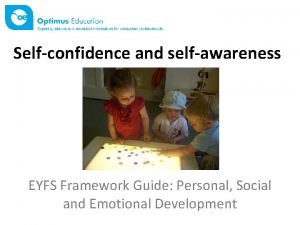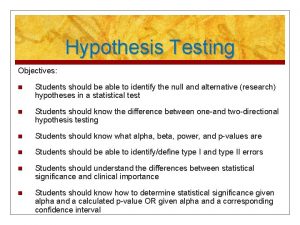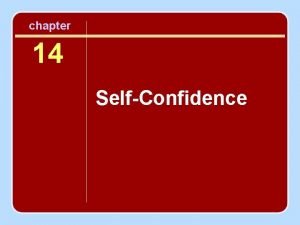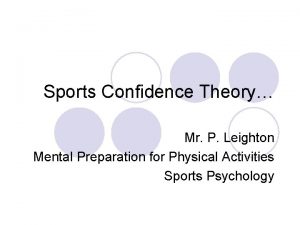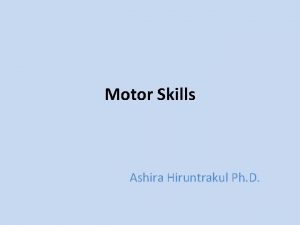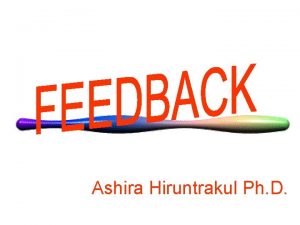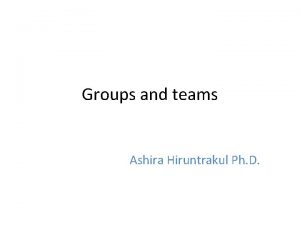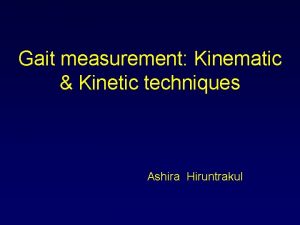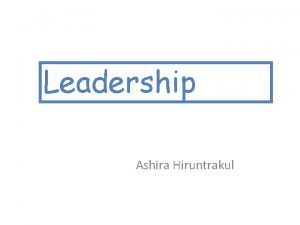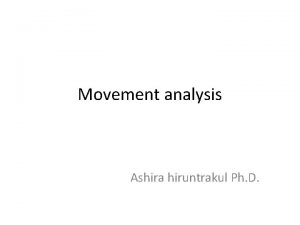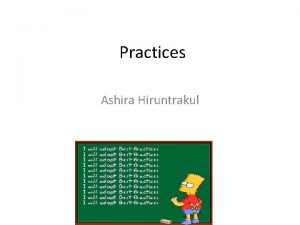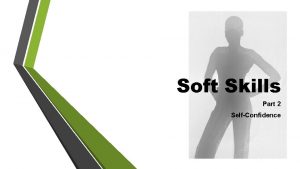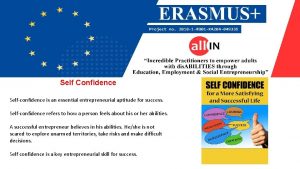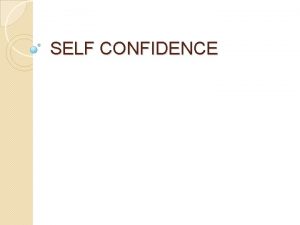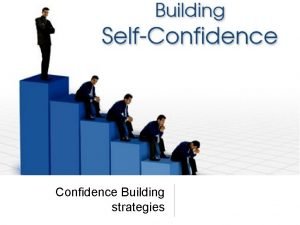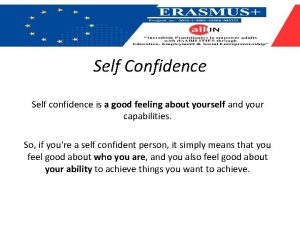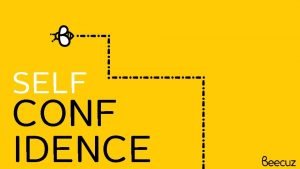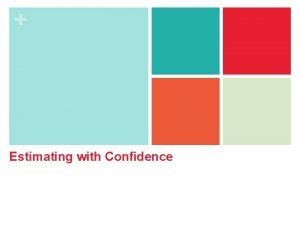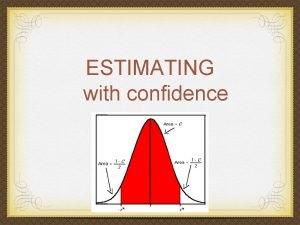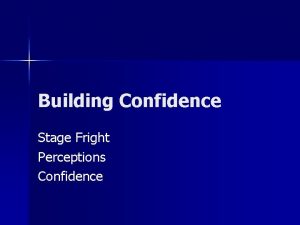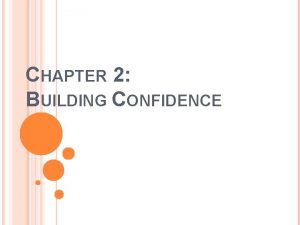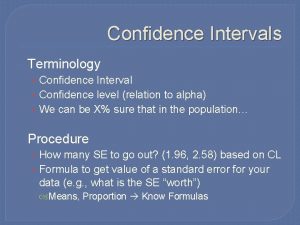Selfconfidence Ashira Hiruntrakul Confidence Self Confidence The state










































- Slides: 42

Self-confidence Ashira Hiruntrakul

Confidence • Self Confidence – The state or quality of being certain in oneself or one’s abilities. • Self confidence is one of the most frequently cited psychological factors thought to effect sport performance (Covassin, 2005).

(+)’s for Possessing Athletic Confidence • Enhances personal well being. • Acquire belief in themselves • Approach difficult tasks as a challenge. • Maintain strong commitment to goals.

(-)’s for Lacking Athletic Confidence • Doubt their capabilities • When faced with difficult tasks, they swell on their personal deficiencies • Give in more easily • Slower to recover from failures and setbacks • Easily fall victim to stress and depression

Models of Self-Confidence • Bandura’s Theory of Self. Efficacy • Harter’s Competence Motivation Theory • Vealey’s Sport Confidence Model

Bandura’s Self–Efficacy Theory Self-efficacy provides a model to study the effects of self-confidence on sport performance, persistence, and behavior. Self-efficacy is important when one has the requisite skills and sufficient motivation.

Bandura’s Self–Efficacy Theory Self-efficacy affects an athlete’s choice of activities, level of effort, and persistence. Although self-efficacy is task-specific, it generalizes to other similar skills and situations. High self-efficacy people set more challenging goals.

Developing Self-Confidence 1. Successful performance 2. Vicarious experience (participatory modeling) 3. Verbal persuasion 4. Emotional arousal Bandura, 1977, 1982, 1997

Bandura’s 4 component Model of Self Efficacy • Performance Accomplishments: • Highlight past successful performances • This has the most powerful effect on Self Efficacy • Vicarious Experiences: • Show the performer a demonstration of the required performance • This will persuade the performer that the task is achievable

• Verbal Persuasion • Verbally encourage performer • Coach/teacher should tell performer that they have the ability to suceed • Emotional Arousal • Get the perfomer to feel confident about his/her level of arousal • To alter the level of arousal to achieve the optimum level

SELF-EFFICACY - BANDURA’S MODEL PERFORMANCE ACCOMPLISHMENTS • consist of past experiences • example : previously performed skill at dribbling a soccer ball • if this is successful • then this leads to greater self-efficacy • at this particular task • in the future VICARIOUS EXPERIENCES • consist of what has been observed in others • performing a similar skill • example : observing another player in your team dribbling a soccer ball • if the model is of similar age / ability • and is successful • then this may lead to greater self-efficacy

SELF-EFFICACY - BANDURA’S MODEL VERBAL PERSUASION • encouragement can lead to greater selfefficacy • if the person giving encouragement is of high status • compared with the performer EMOTIONAL AROUSAL • if arousal is too high – state anxiety - A-state • this could lead to low self-efficacy • mental rehearsal / physical relaxation could – lead to greater confidence – and a calmer approach

Self–Efficacy Sources

Harter’s Competence Motivation Theory • Based on an individual’s feelings of personal competence • Individuals are innately motivated to be competent in all areas of human achievement

High Competence Motivation Self-Efficacy, Positive Affect and Feelings of Competence Low Competence Motivation Negative Affect Successful Performance Fewer Mastery Attempts Unsuccessful Performance Sports Drop-out Innate Motivation to be Competent in Sports: Mastery Attempts Harter’s Competence Motivation Theory

Vealey’s Sport-Specific Model of Sport Confidence • Sport confidence is the belief or degree of certainty individuals possess about their ability to be successful in sport

Sports Confidence Theory… • Vealey (1986) stated that there are 2 factors in sports confidence… • TRAIT SPORT CONFIDENCE (SC Trait) • STATE SPORT CONFIDENCE (SC State)

Trait vs. State • Global self-confidence: A predisposition to feel confident in many situations • Situation-specific selfconfidence: The belief that you can succeed in situation at hand

Trait Sports Confidence… • Is innate and a natural disposition • It is relatively stable. • Trait sports confidence is concerned with how a performer rates their own ability to perform across a wide range of sports.

State Sports Confidence… • State sports confidence can be developed through learning. • At that ends it can be changed. • State confidence is concerned with… – …how a performer rates their own ability to perform at one particular moment.

State Sports Confidence in Action… • This determines the quality of how a skill is performed e. g. • A Putt in Golf. • A Penalty in Football/Rugby. • At this ends State Sports confidence is influenced by…

State Sports Confidence Trait Sports Confidence Objective Sports Situation Competitive Orientation

Vealey’s Model of Sports Confidence… Objective Sport Situation Trait Sports Confidence State Sports Confidence Competitive Orientation Performance of The specific skill Subjective Outcome Of the Skill

Effects of Variation in Levels of Trait Sports Confidence… Decrease in SC Trait and Competitiveness… Depress SC State Increase in SC Trait and Competitiveness… Elevate SC State Reduce Self-Efficacy Increase Self-Efficacy Make the performer less Make the performer confident more confident Avoidance Behaviours Approach Behaviours

How do we improve SC State? • Mastery of Skill: When a skill has been acquired and the performer perceives that progress has been made. • Styling: Confidence will increase if the performer can demonstrate the skill to significant others. • Physical and Mental Preparation: Increases the likelihood of a successful performer. • Social Reinforcement: Praise and approval by significant others, within strong team cohesion situation, will raise confidence. • Effective Leadership: Promotes confidence within team members. • Environmental Comfort: People who lack self confidence will be helped if the working conditions are suitable i. e. novices should not be too closely observed- elite performers at home?

Benefits of Self–Confidence Arouses positive emotions Facilitates concentration Affects the setting and pursuit of challenging goals Increases effort Affects game strategies (play to win versus play to lose) Affects psychological momentum

Levels of Confidence Optimal confidence Lack of confidence Overconfidence

CONFIDENCE SELF-CONFIDENCE • • arouses positive emotions allows the athlete to – remain calm under pressure – be assertive when required • • facilitates concentration enables focus on the important aspects of a task • enables the setting of challenging but realistic goals increases effort • • • affects game strategies – a confident player plays to win even if it means taking risks affects psychological momentum – a confident athlete take each point or play at a time – and never gives up – even when defeat is imminent

SELF-CONFIDENCE LACK OF CONFIDENCE • causes stress under pressure • causes concentration on outside stressors – mistakes – spectators • causes the setting of goals which are either too easy or too hard • causes the athlete to try to avoid mistakes • non-confident athletes find it difficult to reverse negative psychological momentum – once things start to go wrong – it is difficult to think positively OVERCONFIDENCE OR FALSE CONFIDENCE • is dangerous because it can lead to – inadequate preparation – low motivation – low arousal • which are difficult to correct when competition is under way

Optimal Confidence, Under– confidence, and Overconfidence The inverted-U illustrating the confidenceperformance relationship

Building Self-confidence • • • Realistic/Attainable goals Repeated successes Praise & encouragement Learn from your mistakes Practice Sharpen the saw Social support Verbal persuasion Modeling Self-talk

Ways to build Self Confidence • • Self Talk Be an actor Mistakes happen Trust yourself

Self Talk • There is a direct connection between how athletes think about things or how they talk to themselves during competition which can determine how well they will perform.

Negative Thoughts (self Talk) • When athletes judge themselves unfairly, evaluate performances in critical ways, or speak to themselves in negative ways, they are setting themselves up for negative outcomes and failure.

Negative Thoughts (Self Talk) • Don’t mess up • Don’t let the coach down • Don’t let the team down • Your going to lose your position

Positive thoughts (Self Talk) • Team/coach believes in you • Past successful experiences • Worked hard for your position

Be an Actor • • Act in a confident manner Takes mind off of anxiety Helps visualize successful performance Assists in building confidence

Mistakes Happen • Athletes can experience “off days. ” • Don’t let a bad performance shatter an athletes self belief in their abilities

Trust Yourself • Athletes know themselves better than anyone else. – Don’t doubt your abilities, be confident • Don’t give up when things go wrong • Learn from mistakes

Building Self–Confidence Ensure performance accomplishments. Successful behavior increases confidence and leads to further successful behavior. Include good technical, and tactical instruction. Use game-pressure simulations. Act confidently. Instructors-coaches should display confidence. Teach athletes to display confidence.

Building Self–Confidence Use imagery. Imagine yourself as confident and successful. Train for superior physical conditioning. Fatigue erodes confidence & performance Prepare Develop performance plans and routines; plans give you confidence because ____________________

Building Self–Confidence Above all else…Think confidently. Focus on instruction and motivating thoughts. Avoid judgmental thoughts.
 Ashira girls secondary school
Ashira girls secondary school Eyfs self confidence and self awareness
Eyfs self confidence and self awareness Similarities of ideal self and actual self
Similarities of ideal self and actual self Confidence interval vs confidence level
Confidence interval vs confidence level Critical value for z score
Critical value for z score What is self esteem
What is self esteem Self confidence model
Self confidence model Self confidence and assertiveness
Self confidence and assertiveness Self confidence hyphen
Self confidence hyphen Vealeys model
Vealeys model Hát kết hợp bộ gõ cơ thể
Hát kết hợp bộ gõ cơ thể Slidetodoc
Slidetodoc Bổ thể
Bổ thể Tỉ lệ cơ thể trẻ em
Tỉ lệ cơ thể trẻ em Gấu đi như thế nào
Gấu đi như thế nào Chụp tư thế worms-breton
Chụp tư thế worms-breton Chúa yêu trần thế
Chúa yêu trần thế Môn thể thao bắt đầu bằng chữ f
Môn thể thao bắt đầu bằng chữ f Thế nào là hệ số cao nhất
Thế nào là hệ số cao nhất Các châu lục và đại dương trên thế giới
Các châu lục và đại dương trên thế giới Cong thức tính động năng
Cong thức tính động năng Trời xanh đây là của chúng ta thể thơ
Trời xanh đây là của chúng ta thể thơ Mật thư tọa độ 5x5
Mật thư tọa độ 5x5 101012 bằng
101012 bằng độ dài liên kết
độ dài liên kết Các châu lục và đại dương trên thế giới
Các châu lục và đại dương trên thế giới Thơ thất ngôn tứ tuyệt đường luật
Thơ thất ngôn tứ tuyệt đường luật Quá trình desamine hóa có thể tạo ra
Quá trình desamine hóa có thể tạo ra Một số thể thơ truyền thống
Một số thể thơ truyền thống Cái miệng nó xinh thế
Cái miệng nó xinh thế Vẽ hình chiếu vuông góc của vật thể sau
Vẽ hình chiếu vuông góc của vật thể sau Biện pháp chống mỏi cơ
Biện pháp chống mỏi cơ đặc điểm cơ thể của người tối cổ
đặc điểm cơ thể của người tối cổ V cc
V cc Vẽ hình chiếu đứng bằng cạnh của vật thể
Vẽ hình chiếu đứng bằng cạnh của vật thể Tia chieu sa te
Tia chieu sa te Thẻ vin
Thẻ vin đại từ thay thế
đại từ thay thế điện thế nghỉ
điện thế nghỉ Tư thế ngồi viết
Tư thế ngồi viết Diễn thế sinh thái là
Diễn thế sinh thái là Các loại đột biến cấu trúc nhiễm sắc thể
Các loại đột biến cấu trúc nhiễm sắc thể Số nguyên tố là số gì
Số nguyên tố là số gì

